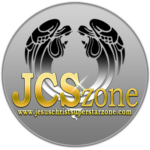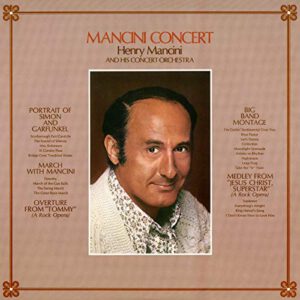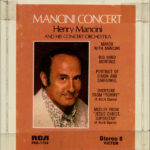Artwork
Cast
Credited to Henry Mancini and His Concert Orchestra
Soloists
Piccolo, Trumpet (Overture From “Tommy”): Bud Brisbois
Bass: Ray Brown
Trumpet (Mrs. Robinson, King Herod’s Song): Pete Candoli
French Horn: Vincent DeRosa
Piano: Pearl Kaufman
Oboe: Arnold Koblentz
Drums: Shelly Manne
Clarinet: Abe Most
Trombone: Dick Nash
Violin: Erno Neufeld
Flute: Ethmer Roten
Trumpet (Cinbiribin), Flugelhorn (Scarborough Fair/Canticle): Graham Young
Track Listing
Side 1:
Portrait Of Simon And Garfunkel (Scarborough Fair/Canticle / The Sound Of Silence / Mrs. Robinson / El Condor Pasa / Bridge Over Troubled Water)*
March With Mancini (Timothy / March Of The Cue Balls / The Swing March / The Great Race March)*
Side 2:
Medley From “Jesus Christ, Superstar” (Superstar / Everything’s Alright / King Herod’s Song / I Don’t Know How To Love Him)
Big Band Montage (I’m Gettin’ Sentimental Over You / Blue Flame / Let’s Dance / Cinbiribin / Moonlight Serenade / Artistry In Rhythm / Nightmare / Leap Frog / Take The “A” Train)*
Overture From “Tommy”*
* denotes a non-JCS track.
Audio Production Information
Produced by Joe Reisman
Recording Engineer: Mickey Crofford
Arranged by Henry Mancini
Recorded at RCA’s Music Center of the World, Hollywood, CA
© 1971, RCA Records. Printed in U.S.A.
Historical Notes from a Fan
When any show is a hit, a lot of people will be quick to capitalize on the show’s success. In this case, Jesus Christ Superstar was one of the first albums of its kind, and everyone wanted their slice of the pie where the Passion According to Tim and Andrew was concerned. At this time, many “budget” labels famous for releasing low-cost sound-alike albums (“knock-off” recordings capitalizing on shows, songs, or albums that became hits) jumped into the fray. The performers were usually never an actual ensemble that had performed JCS (indeed, in its early days, the number of actual casts performing the show was very few), but instead merely a group of vocalists who recorded songs from the show. Usually, these recordings were very cheaply put together and produced, and priced to own. (In the future, albums like these, now labeled “studio cast recordings,” could no longer be accurately described as simple cash grabs, but at the time, the use of the phrase “knock-off” is appropriate.) Though it may be a matter of opinion, this particular fan feels that since the performers on these studio recordings lack the experience of getting on a stage and performing the show in front of an audience, the performances are pleasant enough, but not always up to par with a real cast album.
What can one say about Henry Mancini that has not already been said much better by great experts and enthusiasts alike in his field? Composer, conductor, arranger, pianist, flutist, often cited as one of the greatest composers in film history… one does not simply win four Oscars, twenty Grammys (plus a posthumous Lifetime Achievement Award from same), and a Golden Globe without the kind of talent that spawns “The Pink Panther Theme” and “Moon River” from Breakfast at Tiffany’s. At this moment in his journey, we catch him chasing relevance. As the liner notes make plain, two of his best-selling records at the time were concert albums, and realizing that big band themes of the 1930s and ’40s were no longer paying the bills on their own, he decided to add ’70s rock opera to the mix for his 1971 concert tour of America, in the form of a JCS medley and the overture from Tommy, along with what the liners’ author aptly called “highly individual” takes on Simon and Garfunkel tunes. (Funnily enough, considering the title of the album and its status as a merchandising tie-in, it’s somewhat surprising to note that this album is not a live recording, but a studio rendition of his set from this tour.)
While the contemporary material is inventively arranged (the Simon and Garfunkel section sounds particularly heartfelt for an orchestral rendering), the real stand-outs come when Mancini is playing in his usual sandbox, looking back to his swing era roots in “Big Band Montage” and weaving together a medley of his Peter Gunn and Great Race themes in “March With Mancini.”
Bottom line: if you like this kind of jazz, you’ll like Mancini’s take on Lloyd Webber, but by the same token you’ll probably find it difficult to consider any of his output bad. Having said that, his fans — though of course, one cannot account for individual taste in music outside of his typical oeuvre — rank it everywhere on the scale from “excellent and highly recommended” to “poor, with some listenable tracks.” For JCS fans, the quality ultimately lies in the listener’s ear.
Reviews
There are no reviews yet. Be the first one to write one.


